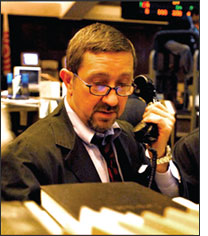Top Talk

Should commodity funds be subject to position limits?  THE TRADER
THE TRADER
Jake Vrabel, a floor trader and 25-year member of CBOT, is senior vice president, grain division, MF Global.
> Level Playing Field
Farmers, commercials, speculators and managed money—whether through traditional or index funds—all have roles in price discovery. To maximize price discovery, there has to be balance among participants; one can't have an unfair advantage over the others.
Traditional funds provide liquidity and price discovery because they buy and sell depending on their reading of the market. What is different about the index funds is that they are always long and never short. They aim to own particular sectors and products with a given percentage of the cash they are managing. Many times prices and supply/demand are irrelevant to index fund managers when deciding the size of their position. Because many index funds hold long positions for an extended period and roll contracts forward, they "absorb liquidity,” not add it to the market, which distorts price discovery.
 THE ANALYST
THE ANALYSTAshley Gulke tracks and analyzes fund positions for the Gulke Group.
> Speculators Carry the Risk Baton
Much like handing the baton to the next member in a relay race, producers can hand off risk to speculators through hedging. Why would we want to limit the amount of risk they will buy? They provide liquidity in the market and may even provide support, keeping prices from falling too low.
It is true that large spec positions have increased leaps and bounds, but their percentage of total open interest (all trading by all entities) has not substantially changed since the 1960s.
In fact, in June 2009, the Commodity Futures Trading Commission published a report that stated: "to date, there is no statistically significant evidence that the position changes of any category or subcategory of traders systematically affect prices. On the contrary, there is evidence that noncommercial entities alter their positions following price changes.”
 THE REGULATOR
THE REGULATORMichael Dunn, CFTC commissioner, serves on the Agricultural Advisory Committee.
> Guard Integrity of U.S. Industry
If we put in position limits, they must also apply to over-the-counter (OTC) markets and must be international. The Commodity Futures Trading Commission (CFTC) does not have the authority to set speculative position limits in all venues, specifically OTC markets and foreign boards of trade.
Unilateral CFTC action in only the markets we currently regulate may not have the desired effect of reining in excessive speculation. Those seeking to evade our limits could simply move to venues outside our authority.
It needs to be made clear that the proposed position limits do not set trading limitations on any particular class of investor, including passively managed long-only index funds. Their sole objective is to prevent excessive speculation by a single entity. I would be interested to hear from the public on whether this incremental approach best addresses the market-wide concerns.
 THE FARMER
THE FARMERJerry McReynolds is a Kansas farmer and member of the National Association of Wheat Growers.
> Control, Not Overregulation
There could be some tweaking in position limits for index funds that would, I think, help the situation of excessive margin calls. We want to keep in mind that speculators are important. We have to have a way to lay off risk; we need someone that's willing to accept that risk.
However, price volatility the past few years has led to reductions in marketing alternatives. A co-op near me used to get by with a line of credit of $3 million, then it needed $5 million; this past fall, it went to $15 million. Its line now is $80 million. Elevators are cautious. We have seen times when we couldn't price our products even though futures prices were good. Some elevators will price only during CBOT open outcry, which may not suit farmers doing field work.
It's important the market functions in a controlled but not overly regulated environment that drives out needed speculation.
Top Producer, February 2010







